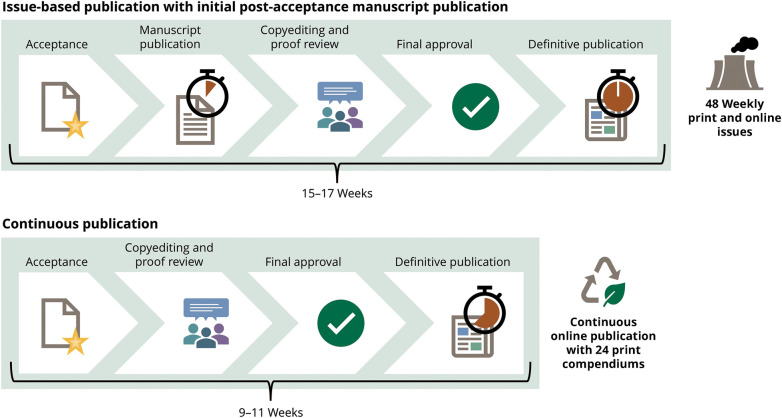Readers will notice that, beginning in 2024, the publication model of Neurology has left behind the concept of the periodical in favor of continuous publication. Continuous publication allows for the definitive, authoritative version of every article to appear online as soon as the authors' final corrections are applied. This differs from our current issue-based model of postacceptance manuscript publication, in which the version published online must still undergo composition, copyediting, and proof review before final publication in an issue. The new system will shorten the time from acceptance to publication with a definitive citation by about 6 weeks (Figure).
Figure. Differences Between the Current and Future Publication Models of Neurology.
Timeliness of publication of manuscripts has always been a priority for Neurology, and it was the reason why the journal increased the number of yearly issues from 6 to 12 in 1953, and from 12 to 48 by 2007; launched online publication ahead of print in 2005 (initially publishing in this manner a quarter of the research articles and all of them in 2011); and began online publication of the postacceptance manuscript in 2020. Our move to continuous publication is the next step in this journey: we will no longer plan around issues, and the online, unabridged, canonical version of every article—with a definitive citation—will be available soon after acceptance. As a reflection of this change, articles will be cited by their e-locator rather than by their page range. The Neurology editorial team has experience in continuous publication. The 3 open-access journals in the Neurology family of journals (Neurology: Neuroimmunology & Neuroinflammation, Neurology: Genetics, and Neurology: Education) were launched with a continuous publication model. The other print journal in the family, Neurology: Clinical Practice, moved to continuous publication at the start of 2023.
Subscribers to Neurology, including members of the American Academy of Neurology, will continue to receive a print compendium of most of the articles published online, mailed the second and fourth Tuesday of every month. Some manuscript types will appear in full-length format in the compendium, whereas others will be listed in the print copy's table of contents but will remain only accessible online. Full-length research articles will continue to appear only online, and the print compendium will include the 2-page short form. By adopting continuous online publication while transitioning to a biweekly schedule for the print copy, the “green journal” will be greener: we will use less paper, plastic wrappers, and postal resources, thereby reducing the journal's carbon footprint. We surveyed visitors to the American Academy of Neurology's website and found that 95% of respondents would prefer receiving 2, instead of 4, print mailings each month, and the editorial team has enthusiastically agreed. We hope that our readership will appreciate our response to the feedback we have received and see the value of accessing our content online, in the unabridged canonical version of the journal, while also receiving a physically abridged version at their home, office, or institution.
The changes herein described will benefit our authors, who will see their articles in the final form earlier, and our readers, who will be able to continue accessing the journal online and with an abridged print version. In addition, they will help the environment by reducing our environmental impact. We look forward to better serving the neurology community with these improvements.
Acknowledgment
The authors thank Kathleen Pieper (Senior Managing Editor of Neurology at the American Academy of Neurology) for her creative contributions to this editorial.
Study Funding
No targeted funding reported.
Disclosure
P.K. Baskin and A. Rahkola are editorial staff for the Neurology journals. J.G. Merino is the editor-in-chief of the Neurology journal. Go to Neurology.org/N for full disclosures.



